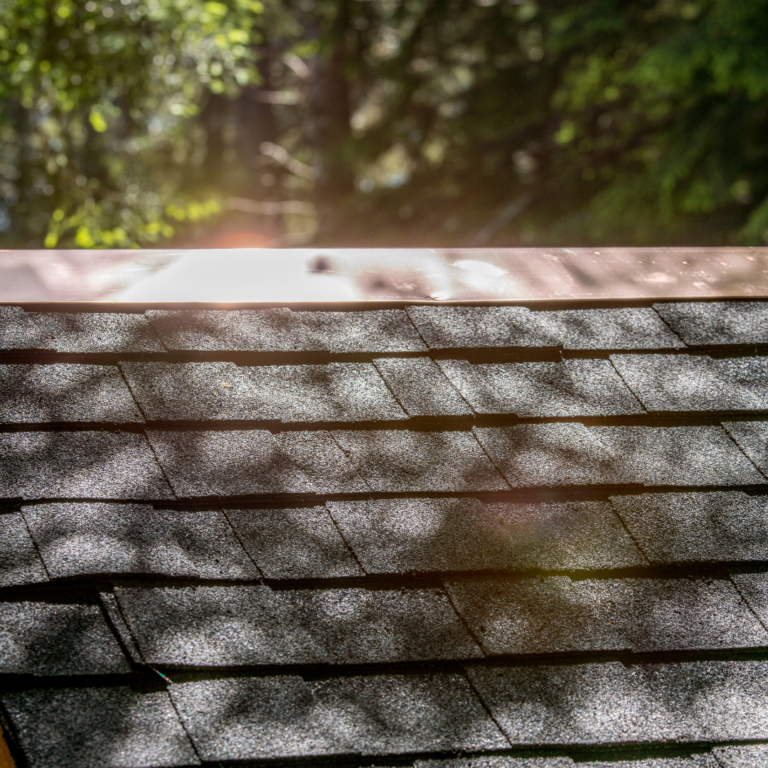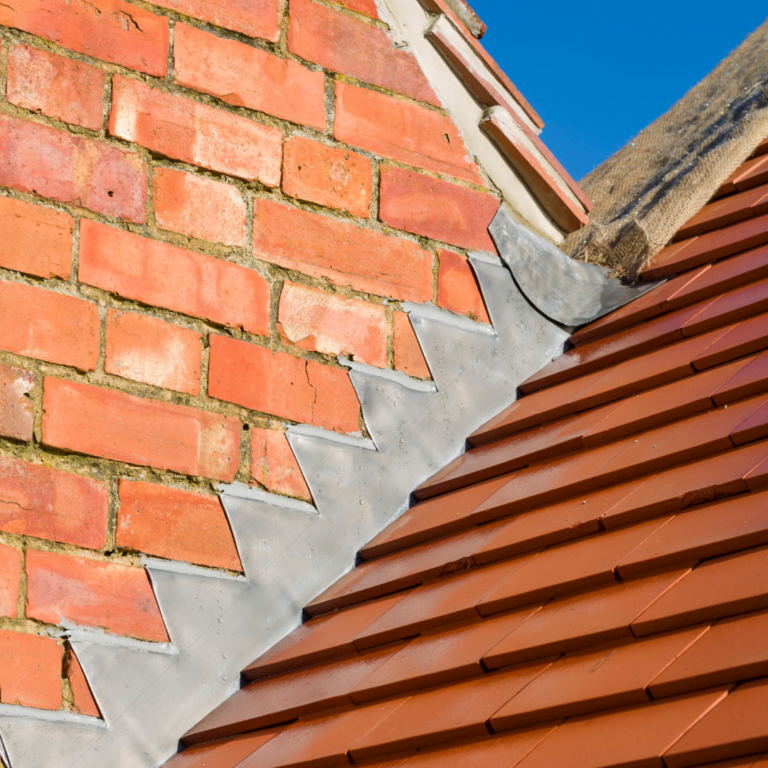“What is roof flashing?” It is one of the most common questions we hear from homeowners. Essentially, roof flashing refers to the thin pieces of metal that help prevent water from seeping into your home. It’s installed at key points on your roof, such as joints, valleys, and edges.
In this article, we’ll explore why roof flashing is important, the different roof flashing types, and how it’s maintained.

Why Is Roof Flashing Important?
Roof flashing is important because it acts as a barrier between your roof and the elements – specifically water. Without proper flashing, rain, snow, and even ice can penetrate the roof structure. This can lead to leaks, mold, and structural damage. Without it, even the most durable roofing materials can fail. But with it, water is directed away from vulnerable areas, thereby extending the life of your roof.
Types of Roof Flashing
There are several roof flashing types, each designed for specific areas of your roof. Understanding these types can help you identify the proper flashing you should have on your roof and why it’s there.
Apron Flashing
Apron flashing, also called continuous flashing, acts a lot like an apron. It’s a long, single piece of metal typically installed at the base of vertical structures (for example, chimneys or dormers). The advantage of using apron flashing is that there are no joints or overlaps that could leak. However, a single piece of metal will have trouble flexing with the changing seasons, meaning it could break or warp over time. For this reason, two-part flashing (counter flashing) is often preferred.
Base and Counter Flashing
Now, you’re probably asking, “What is counter flashing on a roof?” Counter flashing is a two-part flashing system, most often used on chimneys. Base flashing is first installed at the joint (where the roof meets the chimney), then counter flashing is installed above it. The two work together to create a durable, long-lasting barrier against moisture. Plus, they can expand and contract along with natural weather changes.
Drip Edge Flashing
Drip edge flashing is installed along the edges of the roof to direct water away from the fascia and into the gutters. This prevents water from seeping under your shingles, so it’s an essential part of your roof’s overall protection. This type of flashing also helps to prevent water from running down the side of your home, which can cause damage to siding, foundations, and landscaping.
Pipe Flashing
Roofs often have pipes, vents, and other penetrations that need to be sealed to prevent leaks. Just as it sounds, pipe flashing is designed specifically for sealing the base of any pipes protruding your roof. Unlike other roof flashing types, it’s sometimes made of rubber or silicone instead of metal for easier expansion and contraction.
Wall Flashing
Wall flashing is used where the roof meets an exterior wall. This type of flashing prevents water from leaking into the space between the roof and the wall, a common area for leaks if not properly protected. Like other types of flashing, wall flashing directs water away from these vulnerable areas.
Step Flashing
Finally, what is step flashing on a roof? It’s a type of flashing used where the roof meets a vertical surface, like a chimney or wall, in a stepped pattern. Now, you might be wondering, “In what part of roofing is step flashing used?” Typically, step flashing is found along the sides of chimneys, dormers, and skylights. Each piece overlaps the next (ex. step, shingle, step shingle, etc.), creating a watertight seal that guides water down the roof and away from the intersection.
Kickouts
Occasionally, kickouts can be installed on problem areas of your roof to direct rainwater out or away from troublesome areas. For example, at the end of valleys, dormers, and/or the bottom of chimneys.

Roof Flashing Materials
Roof flashing can be made from a variety of materials, each with its own advantages. The most common materials used in roof flashing installation include:
- Aluminum: Lightweight and affordable, aluminum is one of the most popular choices for flashing. It’s resistant to corrosion and easy to work with.
- Copper: Known for its durability and long-lasting qualities, copper flashing is more expensive but highly resistant to weathering.
- Steel: Galvanized steel is strong and durable, making it a common choice for flashing. It’s also resistant to rust, especially when coated with a protective layer.
Roof Flashing Maintenance and Repair
Over time, flashing can corrode, crack, or come loose. This could ultimately lead to leaks and water damage. So, in order to protect your home and extend the life of your roof, it’s important to maintain your roof flashing.
Here are some tips for roof flashing maintenance:
- Regular Inspections: Check your roof flashing twice a year for signs of wear and tear. If you notice any rust, cracks, or damage, consider repairs.
- Clear Debris: Make sure gutters and downspouts are clear so that water flows freely off the roof. Leaves and other debris can trap moisture, leading to flashing damage.
- Seal Cracks: If you see any cracks in your flashing, seal them immediately to prevent further damage. In some cases, it might be best to replace the flashing altogether.
Frequently Asked Questions
Is Flashing Necessary On a Roof?
Absolutely. Flashing is essential for protecting your home from leaks and water damage. Without flashing, water can easily penetrate areas where different sections of the roof meet or where roof elements like chimneys and skylights are installed.
What Does Flashing Look Like?
Roof flashing usually looks like thin metal strips, placed around roof intersections or protrusions like chimneys and skylights. Depending on its location and type, flashing can be either visible or hidden beneath shingles.
What Happens If You Don’t Have Flashing?
Without flashing, water can enter your roof through the gaps, leading to leaks, mold, and even structural damage. Over time, the lack of flashing can cause expensive damage to your home, requiring major repairs to both the roof and interior.
Now, you should know the answer to our most common question – “What is roof flashing?” Here’s a recap: roof flashing is an essential component of any roofing system, designed to prevent water from seeping into your home and causing damage. With different roof flashing types and materials to choose from, proper installation and maintenance are key to ensuring your roof’s long-term durability. Whether it’s step flashing, counter flashing, or pipe flashing, investing in quality roof flashing installation can save you from costly repairs down the road.
If you have questions or need assistance with your roof flashing, give us a call or book a roof inspection today.
